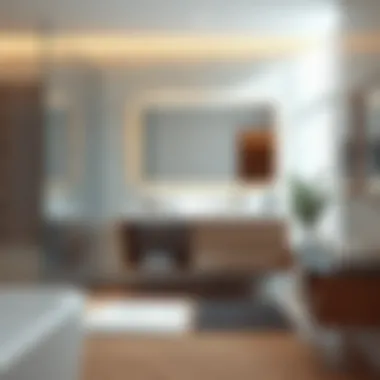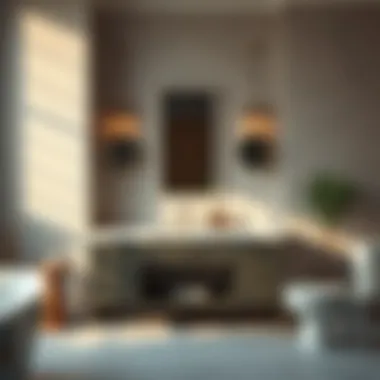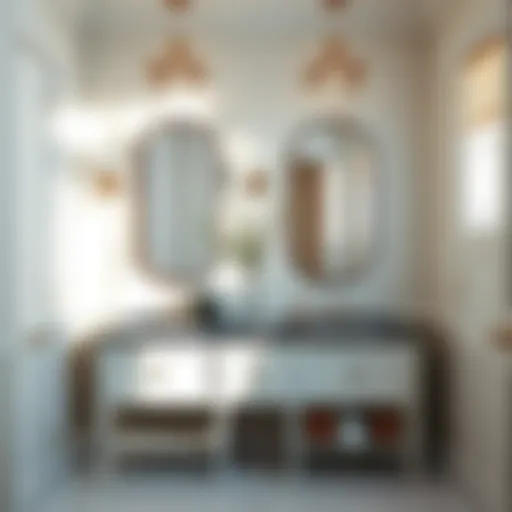Designer Bathroom Vanities: An In-Depth Guide


Intro
The bathroom is no longer just a functional space; it has evolved into a personal sanctuary, a place where style and comfort intersect. Within this transformation, designer bathroom vanities play a pivotal role. Not only do these vanities serve practical purposes, but they also elevate the aesthetics of the entire room. In this comprehensive exploration, we will delve into various elements of designer bathroom vanities, from the latest design trends and choice of materials to insights on how these pieces can optimize space and enhance functionality.
This guide is curated specifically for homeowners and design enthusiasts who aspire to create a stunning and practical bathroom environment. As we scrutinize various aspects surrounding designer vanities, we highlight their significance in modern interiors and the myriad ways they can be tailored to suit individual lifestyles and tastes.
Let’s embark on this journey and discover how the right vanity can transform your bathroom into a stylish retreat.
Design Inspirations
When considering designer bathroom vanities, it is essential to draw inspiration from current trends and themes that resonate with modern aesthetics. The world of bath and bedroom design is constantly changing, offering a plethora of options to choose from.
Latest Trends in Bath and Bedroom Design
Recent trends are steering the design of bathroom vanities towards a more integrated and layered approach. Here are some noteworthy trends:
- Floating Vanities: These offer a sleek, airy feel and create an illusion of space underneath.
- Bold Textures and Materials: Natural stones, reclaimed wood, and metals are gaining traction, providing durability and unique charm.
- Minimalistic Styles: Clean lines and fewer decorative elements are becoming popular as they promote a sense of calm.
- Vintage and Retro Touches: Elements that evoke nostalgia, such as antique hardware and distressed finishes, are making a comeback.
As you consider these aspects, ponder how each trend aligns with your personal style and the overall theme of your home.
Color Palettes and Themes
Choosing the right colors can greatly enhance the mood of your bathroom. Here are some popular palettes:
- Neutral Tones: Shades like beige, greys, and whites created soothing backdrops that pair well with colored accents.
- Earthy Hues: Greens and browns evoke a natural vibe, perfect for those looking to infuse organic elements into their space.
- Bold Statements: Dark colors or vibrant tones can be striking and draw the eye to your vanity as a focal point.
Considering the nuances of color and texture helps create a cohesive look that can transform utilitarian spaces into personal havens.
Functional Elements
Beyond aesthetic appeal, bathroom vanities must also exhibit utility. The balance between design and functionality is key to creating a space that works for you.
Space Optimization Tips
In smaller bathrooms, it’s crucial to maximize every inch. Here are some strategies:
- Use Vertical Space: Tall vanities can provide additional storage without compromising floor space.
- Drawers versus Cabinet Doors: Drawers allow for better organization and are often easier to access.
- Strategic Placement: Positioning the vanity in a corner can create an open feel, making the room appear larger.
Multi-Functional Furniture Choices
Consider vanities that serve multiple purposes. Some vanities come with integrated sinks or additional shelving that provides extra space for toiletries or linen. Here are a few multi-functional choices:
- Vanity with Built-In Storage: Units that combine both function and storage can reduce clutter effectively.
- Convertible Furniture: Look into pieces that can adapt from a low-profile vanity to a sturdy stool or additional seating.
"A well-chosen vanity not only elevates aesthetics but also enhances utility. Remember, the goal is to merge style with function."
As you embark on selecting your designer bathroom vanity, keep in mind these inspirations and functional elements that will ensure you create a space that is not just beautiful, but also serves your daily needs. In the following sections, we'll further analyze materials and ongoing trends to provide a complete overview on designer bathroom vanities.
For more detailed insights, consider visiting
Wikipedia on bathroom design or Britannica additional resources.
Prelims to Designer Bathroom Vanities
In today's world, where interior design has grown into a profound form of self-expression, designer bathroom vanities stand out as functional art pieces. The importance of bathroom vanities goes beyond their mere practical use; they serve as central elements that can transform an ordinary space into a sanctuary of style and comfort. With the right design, a bathroom can reflect personal taste and enhance the overall aesthetic of a home.
Defining Designer Bathroom Vanities
Designer bathroom vanities are more than just storage solutions; they are elegant furniture-like pieces that hold significant influence over the bathroom's atmosphere. These vanities are often characterized by their unique design, high-quality materials, and thoughtful craftsmanship. Think of them as the anchor of a bathroom's decor, tasked with balancing function and style seamlessly. Unlike conventional models which tend to prioritize efficiency over beauty, designer vanities elevate the space, allowing homeowners to revel in opulence.
To put it simply, a well-chosen vanity can set the tone for an entire bathroom, establishing an ambiance that resonates with warmth and sophistication. It's essential to understand that when one opts for a designer piece, they are not just decorating; they are investing in a lifestyle.
Historical Context and Evolution
The evolution of bathroom vanities narrates a broader story about changing human needs and aesthetic preferences. In the early days, bathrooms were purely functional spaces, with minimal emphasis on design. However, as living standards improved and personal well-being became a priority, the concept of bathroom aesthetics started to take center stage.


Fast forward to the mid-20th century; the influence of modernism brought forth sleek lines and minimalist forms, moving away from bulky designs. As homes began to embrace more open and inviting layouts, the bathroom's role evolved accordingly. Homeowners increasingly viewed their bathrooms as personal retreats, and the demand for designer bathroom vanities burgeoned. Today, vanities reflect an array of styles—ranging from rustic farmhouse designs to chic urban aesthetics—tailored to individual preferences.
"The evolution of design reflects not just changes in taste, but also shifts in cultural priorities and lifestyles."
In summary, designer bathroom vanities represent a significant intersection of functionality and beauty. Their importance in modern interiors cannot be overstated, as they carry the dual responsibility of offering practicality while defining the space's character.
Styles of Designer Bathroom Vanities
In the realm of interior design, particularly when it comes to the delicate sanctuary of a bathroom, the style of the vanity plays a make-or-break role. Not just a practical element, bathroom vanities are often the focal points of the space, reflecting the homeowner's personality and taste. The styles of designer bathroom vanities are quite varied, and each brings its own set of aesthetic, functional, and emotional benefits. Understanding these styles helps homeowners make informed choices that will enhance both the beauty and utility of their bathrooms.
Modern Minimalism
Modern minimalism is all about stripping down to the essentials. With sleek lines and a predominantly neutral color palette, modern minimalist vanities offer a sense of calm and simplicity. Characterized by their decluttered look, these vanities often feature integrated sinks and fixtures that contribute to a seamless design.
A modern minimalist vanity can transform a crowded space into a serene escape. The use of high-quality materials such as lacquered wood or smooth stone surfaces underscores a commitment to craftsmanship.
Less is more. In the world of modern minimalism, each element serves a purpose. No excess, just what you need.
- Benefits of modern minimalism:
- Enhanced sense of space and airiness.
- Easy maintenance due to fewer crevices and edges.
- Timeless design that transcends trends.
Classic Elegance
Classic elegance harks back to the refinement of yesteryears. Inspired by traditional designs, these vanities often showcase intricate moldings, rich wood tones, and sometimes ornate embellishments. The attention to detail is paramount, aiming to invoke a sense of heritage and sophistication.
A classic vanity can make a bathroom feel warm and inviting, seamlessly integrating with vintage or modern architecture alike. Rich dark woods like mahogany or walnut can create a stately vibe, while lighter finishes can soften the look and make spaces feel airier.
- Key features of classic elegance:
- Antique mirror finishes and vintage hardware.
- Curved lines and detailed carvings.
- Rich textures and finishes that speak to meticulous craftsmanship.
Contemporary Fusion
Contemporary fusion captures the essence of various styles, combining elements from several design languages. This approach allows for creative expression and often results in beautifully unique vanities that reflect a blend of modern trends and traditional craftsmanship.
For instance, a vanity may feature a sleek countertop paired with rustic wooden bases, or a bold color scheme mixed with intricate details. This eclectic mix can stimulate visual interest and often becomes a conversation starter.
- Why choose contemporary fusion?
- A personalized vanity that tells your unique story.
- The opportunity for creative combinations of materials and colors.
- Flexibility in design allows for adaptation to changing tastes.
Rustic Charm
Rustic charm is all about embracing imperfections and celebrating nature. Often crafted from reclaimed wood or distressed finishes, these vanities evoke a sense of coziness and warmth. Natural textures and earthy colors define this style, making bathrooms feel welcoming and connected to the outside world.
Whether in a cottage by the lake or a suburban home, a rustic vanity enhances the raw beauty of the materials it utilizes. Adding elements like wrought iron hardware or stone basins can heighten the authentic feel, making it perfect for those seeking to create a tranquil, homey atmosphere.
- Features of rustic charm:
- Raw edges and unrefined surfaces.
- Promotion of sustainable and eco-friendly materials.
- Designs that encourage a relaxed, laid-back vibe.
By exploring these various styles, homeowners can better decide what resonates with their aesthetic preferences and practical needs. Each style uniquely contributes to the ambiance of the bathroom, ensuring that the space is not just functional, but also a reflection of personal taste.
Materials Used in Designer Bathroom Vanities
When choosing a bathroom vanity, the materials used can significantly influence its overall feel, durability, and aesthetic appeal. Each type of material brings its own set of qualities to the table, impacting everything from functionality to the visual statement the vanity makes in your home. This section will delve into the three primary materials commonly found in designer bathroom vanities: wood finishes, metal accents, and glass and stone combinations. Understanding these materials is pivotal for homeowners who aim to achieve a balance between beauty and practicality in their bathrooms.
Wood Finishes
Wood has long been a staple in the design of bathroom vanities largely due to its versatility and timeless charm. When selecting wood for a vanity, factors such as grain, stain color, and finish can drastically change its appearance. For instance, oak is known for its durability and prominent grain patterns, making it an excellent choice for rustic styles. On the other hand, maple offers a smoother finish that complements modern minimalist designs.
In addition to aesthetics, wood finishes also offer practical benefits. They can easily be treated to withstand moisture, a vital consideration in bathrooms. Some popular finishes include:


- Lacquer: Provides a glossy finish and is resistant to water.
- Varnish: Offers UV protection, keeping the wood looking fresh over time.
- Oil-based: Allow natural beauty of the wood to shine through but may require more maintenance.
Caring for a wooden vanity involves routine cleaning with appropriate products to prevent damage and maintain its luster.
Metal Accents
Using metal accents in bathroom vanities has surged in popularity, as they add a modern touch and can effectively contrast with wood or stone. Metals like brass, stainless steel, and even bronze can be used as hardware, frames, or decorative features. Each type of metal provides a unique character:
- Brass lends a luxurious feel and often ages beautifully, developing a unique patina.
- Stainless steel is perfect for a contemporary look and offers excellent resistance to corrosion, making it a smart choice in humid spaces.
- Bronze provides a warm tone and can enhance a vintage or industrial aesthetic.
Metal accents not only enhance visual interest but also contribute to the durability of the vanity. They resist wear and tear more effectively compared to some other materials, ensuring that your investment will stand the test of time.
Glass and Stone Combinations
Glass and stone, when combined, create a striking design statement that brings elegance and sophistication to any bathroom. This pairing leverages the transparency of glass with the earthiness of stone materials like marble or granite.
Glass vanity tops are an exciting choice, especially for homeowners seeking a contemporary feel. They can reflect light beautifully, enhancing the overall brightness of the bathroom. However, it is crucial to opt for tempered glass to ensure safety and durability, as this material is treated to withstand heat and impact.
Stone countertops, on the other hand, offer unparalleled luxury and unique patterns that are rarely replicated. Each slab can give a distinctive touch, transforming the vanity into a focal point. Marble provides a classic touch but needs regular sealing to guard against stains, while granite is renowned for its resilience.
A notable consideration when designing with glass and stone is the need for proper installation and ongoing care. Sealants and timely cleaning help maintain their pristine condition and beauty over the years.
In summary, the materials you choose for your bathroom vanity play a pivotal role in shaping both its function and aesthetic. By combining wood finishes, metal accents, as well as glass and stone, you're not just selecting materials; you're crafting an overall experience that significantly impacts your daily routine. Choosing the right materials can elevate your bathroom from a simple washroom to an inviting sanctuary that harmonizes style and efficiency.
Design Considerations for Bathroom Vanities
When you're diving into the world of bathroom design, the vanity is often where practicality meets style. It's not just a block of wood or a sink on a countertop; this piece plays a crucial role in how the overall bathroom functions and feels. Considering elements such as space, functionality, and aesthetic integration is essential. Each aspect not only enhances the user experience but also contributes to the value of the home.
Space and Dimensions
Before you fall head over heels for a stunning vanity, it's vital to measure your bathroom space accurately. Some may think they have a larger area than they do, leading to tight spots that could turn a dream vanity into a nightmare. Generally, a good rule of thumb is to allow at least 36 inches of space in front of the vanity for ease of movement.
This dedicated space not only helps during busy mornings but also keeps things from feeling cramped. Both height and width matter; standard vanities range from 30 to 36 inches in height, but some homeowners might prefer the comfort of a higher unit.
"A small change in dimensions can make a sizable difference in how you perceive the room."
Functionality and Storage Solutions
Functionality is king when selecting a bathroom vanity. Nobody wants their toiletries spilling all over the counter or fishing around for a hairdryer! Prioritize solutions that offer enough storage space for your needs. Drawers, open shelves, and cabinets are your best friends. For instance, using a double vanity can streamline morning routines for couples, while a single, well-organized vanity with drawers can be perfect for a smaller bathroom.
Consider incorporating pull-out drawers for better accessibility. They might cost a tad more upfront, but they can save time and energy in the long run. Plus, thoughtful appliance integration helps declutter the countertop, creating a clean and calming environment.
Aesthetic Integration with Overall Design
The vanity should complement the home's overall style, rather than rebel against it. Think about the other elements in your bathroom - tiles, color schemes, and plumbing fixtures. A rustic, weathered wood vanity might clash with sleek, modern tiles, while a bold, contemporary piece might lose its luster in a classic-themed bathroom.
Colors are essential; a light pastel may brighten a cramped space, making it feel airier. Meanwhile, dark elements can foster a sense of warmth and intimacy. Remember, it’s about harmony.
Incorporate accessories that resonate with the chosen style, like fixtures that match the vanity finish. So, whether you favor cozy rustic charm or sleek modern minimalism, aim for that seamless blend that feels like home.
Clearly, it's not just about picking a pretty piece, rather than how well it fits into the puzzle of your space. Keep these considerations top-of-mind as you embark on your vanity selection journey.
Impact of Bathroom Vanities on Interior Design
When it comes to crafting a stylish and functional bathroom, the bathroom vanity plays a pivotal role. Not only is it a practical fixture, but the vanity also sets the tone for the entire space. This section explores how bathroom vanities influence various aspects of interior design, enhancing both aesthetics and functionality.
Influence on Room Ambiance
The ambiance of a bathroom can make or break the experience one has in it. A well-designed vanity can evoke feelings of luxury or tranquility, depending on the style chosen. For instance, a sleek, modern vanity with clean lines and bright finishes can create a vibrant and energizing environment. In contrast, a rustic wooden vanity may instill a warm and inviting atmosphere, perfect for a relaxing retreat after a long day.
A bathroom's overall feel heavily relies on the chosen color palette and materials. A vanity made of dark, rich woods paired with soft gold accents can create a sense of sophistication, while lighter colors like soft blues or greens can invoke calm and serenity. The right lighting, coupled with a stunning vanity, can significantly enhance the mood of the room, transforming the space into a personal oasis.
"The vanity is not merely a piece of furniture; it is the heart of bathroom design. Its presence reverberates through the ambiance, influencing everything from light to color."


Enhancing Home Value
In the realm of real estate, bathrooms are scrutinized more than ever, particularly by potential buyers. The presence of a stylish, functional designer bathroom vanity can significantly increase a home’s value. It acts as a focal point that showcases both taste and attention to detail, often influencing a buyer's decision.
Investing in high-quality materials or unique designs ensures that the vanity remains timeless and durable. A well-maintained vanity not only boosts property value but also attracts prospective buyers who appreciate contemporary aesthetics and practical design.
Consider the following elements when thinking about enhancing your home value through bathroom vanities:
- Trendy Materials: Choices like quartz or reclaimed wood can create lasting impressions.
- Size and Scale: Opt for sizes that harmonize with the overall space, avoiding overpowering or undersized pieces.
- Customization: Personalized touches, whether through bespoke finishes or unique hardware, can set your vanity apart.
In summary, the bathroom vanity remains a cornerstone of interior design in bathroom spaces. From dictating the ambiance to enhancing a home’s market appeal, it’s evident that investing in the right vanity can yield significant returns, both personally and financially.
Trends in Bathroom Vanity Design
Bathroom vanities have come a long way from simply being practical fixtures in a bathroom. These days, they are crucial components that shape the overall ambiance of the space. Understanding the trends in bathroom vanity design can help homeowners and designers alike elevate the aesthetic and functional aspects of their bathrooms.
One major trend in recent years is the shift towards sustainable and eco-friendly choices. As environmental awareness grows, many homeowners are opting for materials and designs that have a reduced ecological impact. This shift is not just a whim — it represents a deeper commitment to sustainability that resonates with an ethical lifestyle.
Sustainable and Eco-friendly Choices
Sustainable materials are at the forefront of today’s vanity designs. Materials like reclaimed wood or bamboo are popular for their aesthetic appeal and low environmental processing cost. Not only do these materials age beautifully, but they also provide charm and character that mass-produced alternatives often lack.
Additionally, many brands are leaning towards low-VOC (Volatile Organic Compounds) finishes which are safer for the indoor environment. This means less harmful chemicals are emitted, contributing to better air quality in homes. Features like water-saving faucets and energy-efficient lighting are also becoming standard in many designer vanities. Investing in these eco-friendly options not only benefits the environment but also can often lead to lower utility bills over time, creating an economic advantage as well.
Choosing sustainable bathroom vanities is not only good for the planet; it's also a statement of personal values and style.
Smart and Integrated Technology
Another area making waves is the integration of smart technology into bathroom vanities. With the rise of smart homes, it’s no surprise that homeowners are looking for bathrooms that reflect this technological trend. Innovations range from lighting systems that can be adjusted via smartphone apps to medications that pamper the user with customized settings.
Mirrors equipped with built-in LED lighting and touchscreen controls are gaining traction. These mirrors allow users to adjust lighting according to their needs, whether for applying makeup or creating a soft ambiance.
Furthermore, some vanities are being designed with moisture-sensitive electronics that help manage humidity and fan systems that prevent mold growth. This integration ensures a dynamite balance between luxury and practicality.
Maintenance of Designer Bathroom Vanities
Taking good care of designer bathroom vanities is essential for keeping them looking their best and ensuring their longevity. These vanities represent a significant investment in both style and functionality, and their maintenance directly influences not only their aesthetic appeal but also their efficiency in daily use. Knowing how to clean and care for these pieces will extend their life and maintain their original charm.
Cleaning and Care Techniques
Regular cleaning can make a world of difference when it comes to maintaining designer bathroom vanities. Here are some straightforward approaches:
- Gentle Cleansing: Use mild soaps or specialized cleaning solutions designed for the materials of your vanity. Harsh chemicals can cause discoloration or damage.
- Soft Cloths: Opt for soft, lint-free cloths when cleaning. This is particularly crucial for wooden surfaces to prevent scratches and ensure that the surface retains its sheen.
- Avoid Excess Water: When cleaning, avoid saturating surfaces with excessive water. This applies to wood finishes especially, which can warp or swell over time.
- Regular Dusting: Make it a habit to dust your vanity regularly to prevent buildup. This simple activity will help maintain its appearance and fabric integrity.
- Polishing: For wooden vanities, using a suitable polishing product every few months can help to enrich the finish and protect the wood from damage.
"Prevention is better than cure – this is especially true for elegant bathroom vanities. Regular maintenance can save you from costly repairs in the long run."
Deep cleaning should occur at least once every few months. This includes using a soft bristle brush to tackle hard-to-reach areas where grime may accumulate. Pay attention to hinges and handles, as these spots often attract dirt.
Avoiding Common Pitfalls
While taking care of your designer bathroom vanity, there are some common missteps that homeowners should be wary of. Here's a quick rundown on how to avoid those:
- Neglecting Regular Inspections: Don’t wait for visible signs of damage to check on your vanity. Inspect it regularly for minor damages and treat them before they become bigger issues.
- Incorrect Cleaning Products: Some products may be deemed 'universal', but they can do more harm than good. Always check that the cleaning agents are safe for the specific materials your vanity is made of.
- Overloading Storage: It’s tempting to fill vanities to the brim, but this can strain drawers and shelves. Keep organization in check and avoid putting unnecessary weight on the furniture.
- Ignoring Humidity: Bathrooms often have high humidity. Make sure to keep the area well-ventilated to prevent mold and mildew from forming, especially on wooden surfaces.
- Delaying Repairs: Don’t put off repairs. If you notice a chipped finish or a loosened handle, address it right away to prevent further degradation of the vanity.
By following these maintenance tips, you can enhance the lifespan and beauty of your designer bathroom vanity, allowing it to serve as a centerpiece in your bathroom for years to come. For more information on caring for bathroom furniture, look at Wikipedia's article on Furniture Care.
Finale
Bathroom vanities are more than just functional elements of a bathroom; they represent a blend of style, practicality, and personal expression. Throughout our exploration of designer bathroom vanities, a few key themes have emerged. Firstly, the variety of styles, from modern minimalism to rustic charm, highlights how diverse the options are. This means homeowners can find something that truly resonates with their taste and complements other design aspects of their home.
Furthermore, the materials contributing to these vanities, such as hardwood, metal, and stone, not only dictate the aesthetic but also affect durability and maintenance. Choosing the right material can make a world of difference in how easily a vanity can be cleaned and how well it withstands the test of time.
From a design perspective, vanities aren't just standalone pieces but integral parts of the overall bathroom experience. Their placement and functionality can enhance space, making a room feel more cohesive and inviting. When designers and homeowners take time to thoughtfully consider space and dimensions, functionality, as well as aesthetic integration, the final outcome can be far more pleasing.
The evolving trends in bathroom vanities also deserve attention. With a growing emphasis on sustainability, many are now opting for eco-friendly materials and designs that maintain high standards of quality while minimizing environmental impact. Additionally, advancements in technology have led to smart vanities bringing convenience right into the bathroom experience.
To sum it up, selecting a designer bathroom vanity is not just about choosing a pretty face for your space; it involves significant considerations about style, materials, functionality, and trends. As we wrap up this discussion, it’s clear that investing time and thought into designing your bathroom can yield benefits that transcend the visual appeal. A well-crafted vanity can enhance everyday routines, elevate decor, and ultimately add value to a home.
"A bathroom vanity is a reflection of both functionality and style, capturing the essence of personal spaces."















